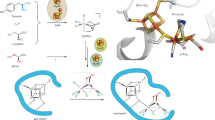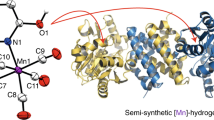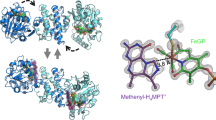Abstract
In biological systems, the cleavage of strong C–H bonds is often carried out by iron centres—such as that of methane monooxygenase in methane hydroxylation—through dioxygen activation mechanisms. High valent species with [Fe2(µ-O)2] diamond cores are thought to act as the oxidizing moieties, but the synthesis of complexes that cleave strong C–H bonds efficiently has remained a challenge. We report here the conversion of a synthetic complex with a valence-delocalized [Fe3.5(µ-O)2Fe3.5]3+ diamond core (1) into a complex with a valence-localized [HO–FeIII–O–FeIV=O]2+ open core (4), which cleaves C–H bonds over a million-fold faster. This activity enhancement results from three factors: the formation of a terminal oxoiron(iv) moiety, the conversion of the low-spin (S = 1) FeIV=O centre to a high-spin (S = 2) centre, and the concentration of the oxidizing capability to the active terminal oxoiron(iv) moiety. This suggests that similar isomerization strategies might be used by nonhaem diiron enzymes.
This is a preview of subscription content, access via your institution
Access options
Subscribe to this journal
Receive 12 print issues and online access
$259.00 per year
only $21.58 per issue
Buy this article
- Purchase on Springer Link
- Instant access to full article PDF
Prices may be subject to local taxes which are calculated during checkout





Similar content being viewed by others
References
Christmann, M. Selective oxidation of aliphatic C–H bonds in the synthesis of complex molecules. Angew. Chem. Int. Ed. 47, 2740–2742 (2008).
Sono, M., Roach, M. P., Coulter, E. D. & Dawson, J. H. Heme-containing oxygenases. Chem. Rev. 96, 2841–2887 (1996).
Wallar, B. J. & Lipscomb, J. D. Dioxygen activation by enzymes containing binuclear non-heme iron clusters. Chem. Rev. 96, 2625–2658 (1996).
Solomon, E. I. et al. Geometric and electronic structure/function correlations in non-heme iron enzymes. Chem. Rev. 100, 235–349 (2000).
Costas, M., Mehn, M. P., Jensen, M. P. & Que, L., Jr. Oxygen activation at mononuclear nonheme iron: Enzymes, intermediates, and models. Chem. Rev. 104, 939–986 (2004).
Krebs, C., Fujimori, D. G., Walch, C. T. & Bollinger, J. M. Jr. Non-heme Fe(iv)–oxo intermediates. Acc. Chem. Res. 40, 484–492 (2007).
Fujii, H. Electronic structure and reactivity of high-valent oxo iron porphyrins. Coord. Chem. Rev. 226, 51–60 (2002).
Groves, J. T. in Cytochrome P450: Structure, Mechanism, and Biochemistry 3rd edn (ed. Ortiz de Montellano, P. R.) 1–43 (Kluwer Academic/Plenum Publishers, 2005).
Shu, L. et al. An FeIV2O2 diamond core structure for the key intermediate Q of methane monooxygenase. Science 275, 515–518 (1997).
Siegbahn, P. E. M. Theoretical model studies of the iron dimer complex of MMO and RNR. Inorg. Chem. 38, 2880–2889 (1999).
Baik, M.-H., Newcomb, M., Friesner, R. A. & Lippard, S. J. Mechanistic studies on the hydroxylation of methane by methane monooxygenase. Chem. Rev. 103, 2385–2420 (2003).
Riggs-Gelasco, P. J. et al. EXAFS characterization of the intermediate X generated during the assembly of the Escherichia coli ribonucleotide reductase R2 diferric-tyrosyl radical cofactor. J. Am. Chem. Soc. 120, 849–860 (1998).
Younker, J. M. et al. Structural analysis of the Mn(iv)/Fe(iii) cofactor of Chlamydia trachomatis ribonucleotide reductase by extended X-ray absorption fine structure spectroscopy and density functional theory calculations. J. Am. Chem. Soc. 130, 15022–15027 (2008).
Dong, Y. et al. A high-valent nonheme iron intermediate. Structure and properties of [Fe2(μ−O)2(5-Me-TPA)2](ClO4)3 . J. Am. Chem. Soc. 117, 2778–2792 (1995).
Hsu, H.-F., Dong, Y., Shu, L., Young, V. G., Jr. & Que, L., Jr. Crystal structure of a synthetic high-valent complex with an Fe2(μ-O)2 diamond core. Implications for the core structures of methane monooxygenase intermediate Q and ribonucleotide reductase intermediate X. J. Am. Chem. Soc. 121, 5230–5237 (1999).
Xue, G. et al. A synthetic precedent for the [FeIV2(μ-O)2] diamond core proposed for methane monooxygenase intermediate Q. Proc. Natl Acad. Sci. USA 104, 20713–20718 (2007).
Xue, G., Fiedler, A. T., Martinho, M., Münck, E. & Que, L., Jr. Insights into the P-to-Q conversion in the catalytic cycle of methane monooxygenase from a synthetic model system. Proc. Natl Acad. Sci. USA 105, 20615–20620 (2008).
Kumar, D., Hirao, H., Que, L., Jr. & Shaik, S. Theoretical investigation of C–H hydroxylation by (N4Py)FeIV=O2+: An oxidant more powerful than P450? J. Am. Chem. Soc. 127, 8026–8027 (2005).
Hirao, H., Kumar, D., Que, L., Jr & Shaik, S. Two-state reactivity in alkane hydroxylation by non-heme iron-oxo complexes. J. Am. Chem. Soc. 128, 8590–8606 (2006).
Decker, A. et al. Spectroscopic and quantum chemical studies on low-spin FeIV=O complexes: Fe–O bonding and its contributions to reactivity. J. Am. Chem. Soc. 129, 15983–15996 (2007).
Shan, X. & Que, L., Jr. High-valent nonheme iron-oxo species in biomimetic oxidations. J. Inorg. Biochem. 100, 421–433 (2006).
Que, L., Jr. The road to non-heme oxoferryls and beyond. Acc. Chem. Res. 40, 493–500 (2007).
Pestovsky, O. et al. Aqueous FeIV=O: Spectroscopic identification and oxo group exchange. Angew. Chem. Int. Ed. 44, 6871–6874 (2005).
Dong, Y., Que, L., Jr., Kauffmann, K. & Münck, E. An exchange-coupled complex with localized high-spin FeIV and FeIII sites of relevance to cluster X of Escherichia coli ribonucleotide reductase. J. Am. Chem. Soc. 117, 11377–11378 (1995).
Zheng, H., Yoo, S. J., Münck, E. & Que, L., Jr. The flexible Fe2(μ-O)2 diamond core: A terminal iron(iv)-oxo species generated from the oxidation of a bis(μ-oxo)diiron(iii) complex. J. Am. Chem. Soc. 122, 3789–3790 (2000).
England, J. et al. A synthetic high-spin oxoiron(iv) complex. Generation, spectroscopic characterization and reactivity. Angew. Chem. Int. Ed. 48, 3622–3626 (2009).
Gupta, R. & Borovik, A. S. Monomeric MnIII/II and FeIII/II complexes with terminal hydroxo and oxo ligands: Probing reactivity via O–H bond dissociation energies. J. Am. Chem. Soc. 125, 13234–13242 (2003).
Ravi, N., Bollinger, J. M., Jr., Huynh, B. H., Edmondson, D. E. & Stubbe, J. Mechanism of assembly of the tyrosyl radical-diiron(iii) cofactor of E. coli ribonucleotide reductase. 1. Mössbauer characterization of the diferric radical precursor. J. Am. Chem. Soc. 116, 8007–8014 (1994).
Sturgeon, B. E. et al. Reconsideration of X, the diiron intermediate formed during cofactor assembly in E. coli ribonucleotide reductase. J. Am. Chem. Soc. 118, 7551–7557 (1996).
Münck, E. in Physical Methods in Bioinorganic Chemistry. Spectroscopy and Magnetism (ed Que, L. Jr.) 287–319 (University Science Books, 2000).
Luo, Y.-R. Comprehensive Handbook of Chemical Bond Energies (CRC Press, 2007).
Bollinger, J. M., Jr. & Krebs, C. Stalking intermediates in oxygen activation by iron enzymes: Motivation and method. J. Inorg. Biochem. 100, 586–605 (2006).
Martinho, M. et al. Mössbauer and DFT study of the ferromagnetically coupled diiron(iv) precursor to a complex with an FeIV2O2 diamond core. J. Am. Chem. Soc. 131, 5823–5830 (2009).
Shaik, S., Hirao, H. & Kumar, D. Reactivity of high-valent iron-oxo species in enzymes and synthetic reagents: a tale of many states. Acc. Chem. Res. 40, 523–542 (2007).
Michel, C. & Baerends, E. J. What singles out the FeO2+ moiety? A density-functional theory study of the methane-to-methanol reaction catalyzed by the first row transition-metal oxide dications MO(H2O)p2+, M=V-Cu. Inorg. Chem. 48, 3628–3638 (2009).
Han, A.-R. et al. Direct evidence for an iron(iv)-oxo porphyrin π-cation radical as an active oxidant in catalytic oxygenation reactions. Chem. Commun. 2008, 1076–1078 (2008).
Bell, S. R. & Groves, J. T. A highly reactive P450 model compound I. J. Am. Chem. Soc. 131, 9640–9641 (2009).
Wang, D., Farquhar, E. R., Stubna, A., Münck, E. & Que, L., Jr. A diiron(iv) complex that cleaves strong C–H and O–H bonds. Nature Chem. 1, 145–150 (2009).
Mayer, J. M. Hydrogen atom abstraction by metal-oxo complexes: Understanding the analogy with organic radical reactions. Acc. Chem. Res. 31, 441–450 (1998).
Bordwell, F. G., Cheng, J.-P., Ji, G.-Z., Satish, A. V. & Zhang, X. Bond dissociation energies in DMSO related to the gas phase. J. Am. Chem. Soc. 113, 9790–9795 (1991).
Gardner, K. A. & Mayer, J. M. Understanding C–H bond oxidations: H• and H− transfer in the oxidation of toluene by permanganate. Science 269, 1849–1851 (1995).
Augustin-Nowacka, D. & Chmurzyňski, L. A potentiometric study of acid-base equilibria of substituted pyridines in acetonitrile. Anal. Chim. Acta 381, 215–220 (1999).
Yin, G. et al. Oxidative reactivity difference among the metal oxo and metal hydroxo moieties: ph dependent hydrogen abstraction by a manganese(iv) complex having two hydroxide ligands. J. Am. Chem. Soc. 130, 16245–16253 (2008).
Parsell, T. H., Yang, M.-Y. & Borovik, A. S. C-H Bond Cleavage with reductants: Re-investigating the reactivity of monomeric MnIII/IV-oxo complexes and the role of oxo ligand basicity. J. Am. Chem. Soc. 131, 2762–2763 (2009).
Johansson, A. J., Noack, H., Siegbahn, P. E. M., Xue, G. & Que, L., Jr. Observed enhancement of the catalytic activity of a biomimetic diiron complex by the addition of water - mechanistic insights from theoretical modeling. Dalton Trans. 4741–4750 (2009).
Siegbahn, P. E. M. & Crabtree, R. H. Mechanism of C–H Activation by diiron methane monooxygenases: quantum chemical studies. J. Am. Chem. Soc. 119, 3103–3113 (1997).
Rinaldo, D., Philipp, D. M., Lippard, S. J. & Friesner, R. A. Intermediates in dioxygen activation by methane monooxygenase: A QM/MM study. J. Am. Chem. Soc. 129, 3135–3147 (2007).
Acknowledgements
This work was supported by NIH grants GM38767 (to L.Q.) and EB-001475 (to E.M.).
Author information
Authors and Affiliations
Contributions
G.X., E.M. and L.Q. conceived and designed the experiments; G.X. and R.D.H. performed the experiments and analysed the data; G.X., R.D.H., E.M. and L.Q. co-wrote the paper.
Corresponding authors
Ethics declarations
Competing interests
The authors declare no competing financial interests.
Supplementary information
Supplementary information
Supplementary information (PDF 2078 kb)
Rights and permissions
About this article
Cite this article
Xue, G., De Hont, R., Münck, E. et al. Million-fold activation of the [Fe2(µ-O)2] diamond core for C–H bond cleavage. Nature Chem 2, 400–405 (2010). https://doi.org/10.1038/nchem.586
Received:
Accepted:
Published:
Issue Date:
DOI: https://doi.org/10.1038/nchem.586
This article is cited by
-
On the origin of multihole oxygen evolution in haematite photoanodes
Nature Catalysis (2022)
-
Determination of the iron(IV) local spin states of the Q intermediate of soluble methane monooxygenase by Kβ X-ray emission spectroscopy
JBIC Journal of Biological Inorganic Chemistry (2022)
-
X-ray absorption spectroscopic characterization of the diferric-peroxo intermediate of human deoxyhypusine hydroxylase in the presence of its substrate eIF5a
JBIC Journal of Biological Inorganic Chemistry (2016)
-
Structure of the key species in the enzymatic oxidation of methane to methanol
Nature (2015)
-
Breaking methane
Nature (2015)



